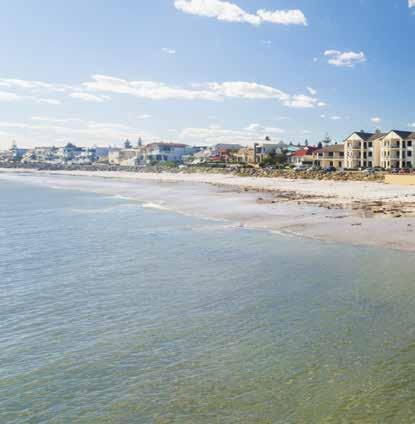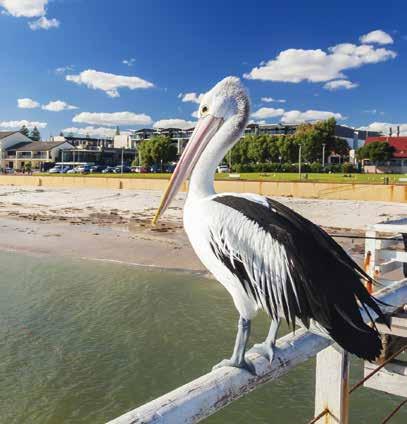
5 minute read
New ways of living
Upsizing, co-habitation, dual-country residency … just some of the ways Australians are choosing to live as they get older.
By Nadia Howland.
Advertisement
When Con, 68, and his partner Sally, 70, retired, they decided to split their time between the Gold Coast and Catania (pictured opposite) in Sicily, where Con was born and raised before he and his parents emigrated to Australia.
“When I met Sally and she found out I had dual citizenship, we decided we would go over for three months,” he recalls. “We just fell in love with the place immediately. Sicily is beautiful, the people are so friendly and the cost of living is incredibly cheap compared to Australia.” The couple own an apartment in Currumbin on the Gold Coast which they rent to holidaymakers while they’re overseas.
“When we’re in Catania, we live in what is essentially a granny flat on a property owned by my cousin,” Con explains.
“Rent-wise it costs us almost nothing. And you can live on fresh seafood and produce from the markets for next to nothing. Eating out is cheap as well. We can have a pasta, a fresh salad and a glass of wine at our favourite restaurant for $20.”
The best part about living between two countries, Con says, is you can chase the sun and enjoy a year-long summer with friends and relatives all over the world.
Con and Sally aren’t the only ones considering a life abroad after retirement.
In fact, it’s something more older Australians are starting to consider, according to research by the Queensland University of Technology Entrepreneurship Program.
“While they’ve been spending all this time stuck in their houses, they have been thinking about how they’re going to spend the next segment of their life,” says researcher Brian Houston. “They see this as an opportunity to keep their brains active and do something new.”
The research team say the average Australian has about $160,000 in super at the age of 60, which isn’t enough to guarantee a good quality of life. But living abroad offers them a way to achieve an improved quality of life for less.
“There are some countries that have reciprocal pension programs so that you can actually receive your pension over there.
“In some cases, people may find it’s also a method for recharging their super. Once you retire, your super continues to accumulate interest and investment returns come through. If you take away the pressure of having to live off that and were to live abroad for a period of time, you may find you gain during that period and can return to Australia with more super than you had when you left.”
There are some countries that have reciprocal pension programs –you can actually receive your pension while you're living there
Down on the farm
When Jean, 62, told her family about her plan to move to the country and build a home and hobby farm, they thought she’d lost the plot. “My daughter was very upset. She said, ‘Mum, you can’t move to the mountains by yourself. You’ve got no idea about farming, and you’ve rented your whole life. This is crazy,’” Jean recalls.
As a single mother of three, Jean had always dreamed of owning her own home and having space for a garden and animals. “A friend told me about a parcel of land for sale near her and her husband, and it was more affordable than anything near where I was living on the coast,” she says.
“The initial plan was to build something small, but I ended up building extra bedrooms with a laundry and kitchenette downstairs so that my children and grandchildren could come and stay.”
Upsizing on a single income was a daunting idea initially, but Jean says her cost of living has decreased markedly since moving to the country.
“I grow a lot of my own fruit and veg, and I don’t eat a lot of meat,” she says. “When you don’t have a supermarket down the road, you learn to be pretty self-sufficient and plan your shops accordingly.
“I have wonderful neighbours nearby, too and if we need something, we’re always able to help each other out. “This may not be my forever home. As I grow older, I will likely need to sell and move closer to my daughters. But for now, it’s exactly what I’ve always wanted and I couldn’t be happier."
Village people
While the idea of communal living might not be new, the modern reinvention of co-living is picking up steam in Australia. And Lyndall Parris is a confirmed convert.
When two of her friends’ husbands died more than a decade ago, leaving them to bring up their children alone, Parris had a thought.
As I grow older, I will likely need to sell and move closer to my daughters. But for now, it’s exactly what I’ve always wanted.
“This is crazy,” she told The Guardian newspaper. “I can’t help them much because they’re living in different places … but if we were living together in a village, wouldn’t it be easier?”
Parris began researching alternative living options and built a website to connect with others seeking co-living arrangements.
In 2012, 24 liked-minded folk pooled their money to buy a 68-hectare plot of land outside Gosford on the NSW Central Coast that would eventually become known as Narara Ecovillage (pictured far right).
The ecovillage is one of an increasing number of communities around the world that engage in what’s known as collaborative living, where multiple people live together in a shared space.
Today, Narara is home to 250 residents who share lives, front yards and meals. Disagreements are settled via “listening circles”, while property upkeep is managed through working bees, to which residents must commit at least 52 hours a year.
As Parris says, “Nobody comes here if they don’t want to say hello to their neighbours.” Co-operative living might not be for everyone, but it could appeal to older Australians looking to minimise their footprint and live in a community of likeminded peers.
One big happy family
For Dayyaan, 54, and Meme, 52, raising their teenage sons near the beach in South Australia (above) has been a dream come true. Moving to Australia from Pakistan to pursue a career in medicine meant Dayyaan, an only child, had to leave his parents behind. “It was hard being separated from them, especially when my father’s health began to decline,” he explains. After many years spent trying to bring his parents to Australia, Dayyaan has finally succeeded.
“In our culture, it is customary for the grandparents to live with family members instead of going to aged care,” he says.
“We are doing the opposite to a lot of our friends. As their children get closer to university age, they are looking at downsizing. It was a surprise to them, I think, seeing us looking for the biggest house we could find.
“With my parents moving in with us, we will have the six of us here under one roof for hopefully many years to come. My sons are both planning to go to university so they will not be moving out of home for a while. It is ideal in many respects as they will be old enough to appreciate the time they have with their grandparents, who they have only visited a handful of times in their life.”
When asked what his parents are most looking forward to about living together, Dayyaan says, “They are excited to see the beach and to spend time with my sons and my wife. My mother wants to teach my wife and my eldest son to cook traditional meals. My father is already asking me for photos of the backyard so he can work out what he is going to plant.” ACG
An edited version of a story that appeared on the National Seniors Australia website (nationalseniors.com.au). Reprinted with kind permission.






